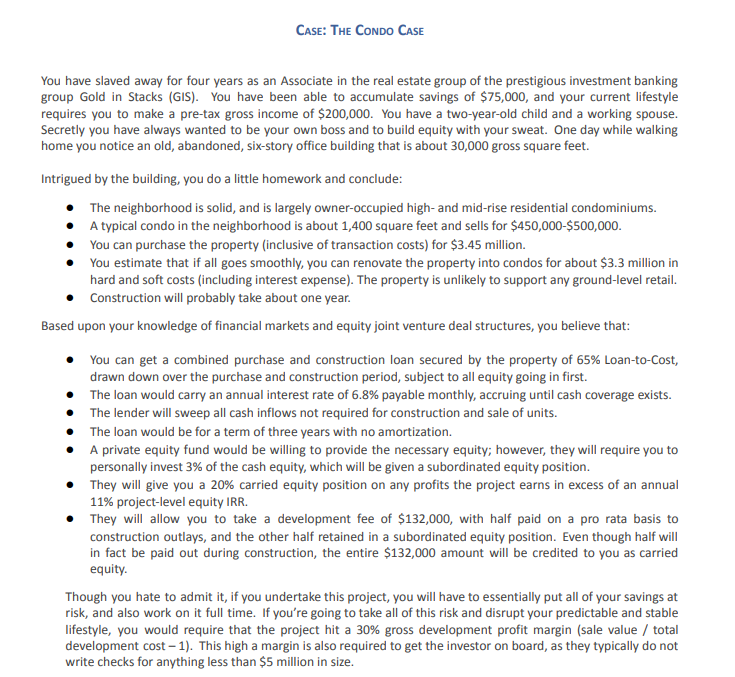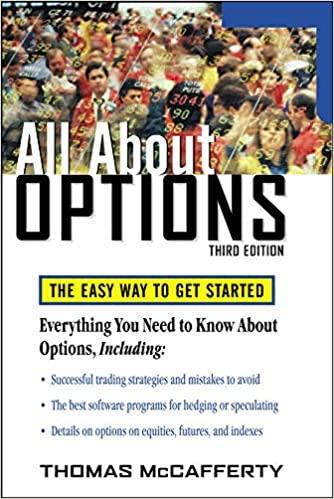I would greatly appreciate someone helping me with this question, please!! I'm super confused with how I would show on a quarterly basis the expected project cash flows for this case study scenario.


CASE: THE CONDO CASE You have slaved away for four years as an Associate in the real estate group of the prestigious investment banking group Gold in Stacks (GIS). You have been able to accumulate savings of $75,000, and your current lifestyle requires you to make a pre-tax gross income of $200,000. You have a two-year-old child and a working spouse. Secretly you have always wanted to be your own boss and to build equity with your sweat. One day while walking home you notice an old, abandoned, six-story office building that is about 30,000 gross square feet. Intrigued by the building, you do a little homework and conclude: The neighborhood is solid, and is largely owner-occupied high-and mid-rise residential condominiums. A typical condo in the neighborhood is about 1,400 square feet and sells for $450,000-$500,000. You can purchase the property (inclusive of transaction costs) for $3.45 million. You estimate that if all goes smoothly, you can renovate the property into condos for about $3.3 million in hard and soft costs (including interest expense). The property is unlikely to support any ground-level retail. Construction will probably take about one year. Based upon your knowledge of financial markets and equity joint venture deal structures, you believe that: You can get a combined purchase and construction loan secured by the property of 65% Loan-to-Cost, drawn down over the purchase and construction period, subject to all equity going in first. The loan would carry an annual interest rate of 6.8% payable monthly, accruing until cash coverage exists. The lender will sweep all cash inflows not required for construction and sale of units. The loan would be for a term of three years with no amortization. A private equity fund would be willing to provide the necessary equity; however, they will require you to personally invest 3% of the cash equity, which will be given a subordinated equity position. They will give you a 20% carried equity position on any profits the project earns in excess of an annual 11% project-level equity IRR. They will allow you to take a development fee of $132,000, with half paid on a pro rata basis to construction outlays, and the other half retained in a subordinated equity position. Even though half will in fact be paid out during construction, the entire $132,000 amount will be credited to you as carried equity. Though you hate to admit it, if you undertake this project, you will have to essentially put all of your savings at risk, and also work on it full time. If you're going to take all of this risk and disrupt your predictable and stable lifestyle, you would require that the project hit a 30% gross development profit margin (sale value / total development cost - 1). This high a margin is also required to get the investor on board, as they typically do not write checks for anything less than $5 million in size. The Assignment . Provide a 1-page project summary (# units of each type, size, target price, when sold, total cost, etc.) Provide a 1-page spreadsheet showing (on a quarterly basis) the expected project cash flows Provide a 1-page summary of the project's unleveraged IRR, equity IRR, and your developer return Provide a two-page summary of what you have decided to do regarding this project (and why) Provide a one-page floorplan summary. . CASE: THE CONDO CASE You have slaved away for four years as an Associate in the real estate group of the prestigious investment banking group Gold in Stacks (GIS). You have been able to accumulate savings of $75,000, and your current lifestyle requires you to make a pre-tax gross income of $200,000. You have a two-year-old child and a working spouse. Secretly you have always wanted to be your own boss and to build equity with your sweat. One day while walking home you notice an old, abandoned, six-story office building that is about 30,000 gross square feet. Intrigued by the building, you do a little homework and conclude: The neighborhood is solid, and is largely owner-occupied high-and mid-rise residential condominiums. A typical condo in the neighborhood is about 1,400 square feet and sells for $450,000-$500,000. You can purchase the property (inclusive of transaction costs) for $3.45 million. You estimate that if all goes smoothly, you can renovate the property into condos for about $3.3 million in hard and soft costs (including interest expense). The property is unlikely to support any ground-level retail. Construction will probably take about one year. Based upon your knowledge of financial markets and equity joint venture deal structures, you believe that: You can get a combined purchase and construction loan secured by the property of 65% Loan-to-Cost, drawn down over the purchase and construction period, subject to all equity going in first. The loan would carry an annual interest rate of 6.8% payable monthly, accruing until cash coverage exists. The lender will sweep all cash inflows not required for construction and sale of units. The loan would be for a term of three years with no amortization. A private equity fund would be willing to provide the necessary equity; however, they will require you to personally invest 3% of the cash equity, which will be given a subordinated equity position. They will give you a 20% carried equity position on any profits the project earns in excess of an annual 11% project-level equity IRR. They will allow you to take a development fee of $132,000, with half paid on a pro rata basis to construction outlays, and the other half retained in a subordinated equity position. Even though half will in fact be paid out during construction, the entire $132,000 amount will be credited to you as carried equity. Though you hate to admit it, if you undertake this project, you will have to essentially put all of your savings at risk, and also work on it full time. If you're going to take all of this risk and disrupt your predictable and stable lifestyle, you would require that the project hit a 30% gross development profit margin (sale value / total development cost - 1). This high a margin is also required to get the investor on board, as they typically do not write checks for anything less than $5 million in size. The Assignment . Provide a 1-page project summary (# units of each type, size, target price, when sold, total cost, etc.) Provide a 1-page spreadsheet showing (on a quarterly basis) the expected project cash flows Provide a 1-page summary of the project's unleveraged IRR, equity IRR, and your developer return Provide a two-page summary of what you have decided to do regarding this project (and why) Provide a one-page floorplan summary








